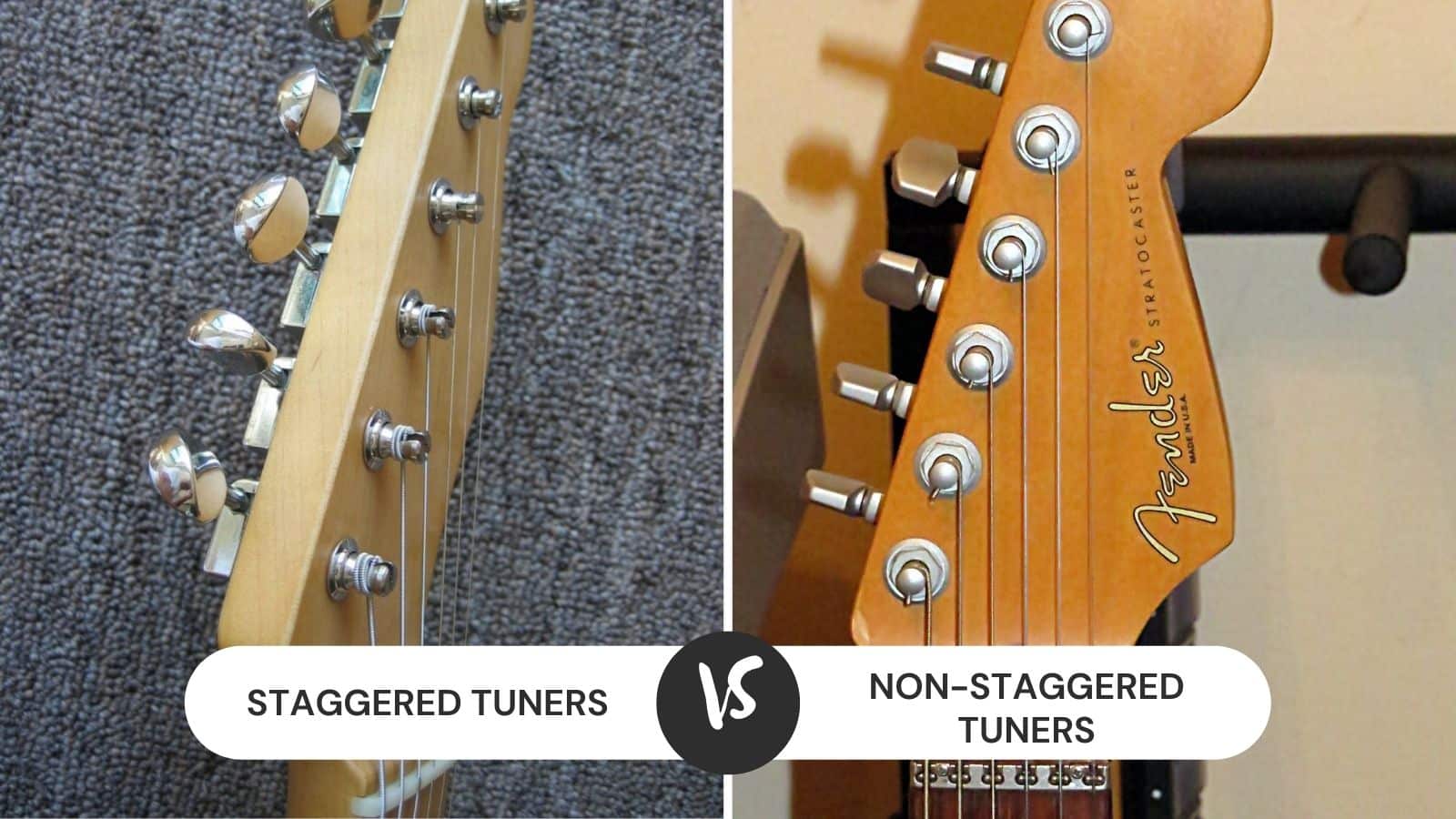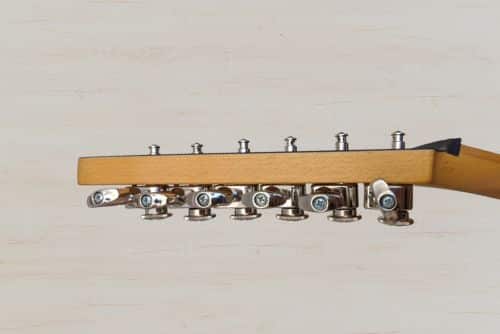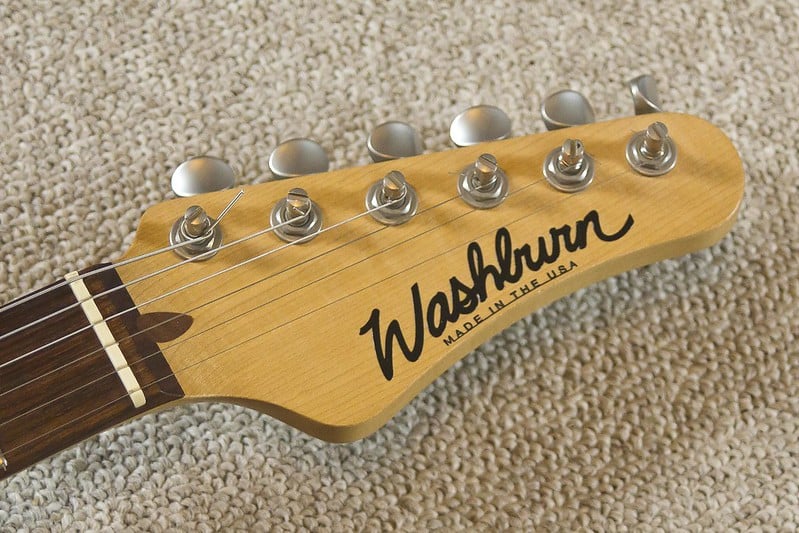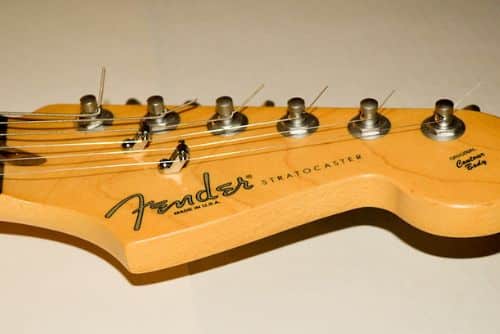
Music is a complex field to work in, and those who create music should utilize a variety of equipment to improve their work, one of which is a tuner. The tuner is intended to measure the frequencies produced by the vibrating strings of an electric guitar.
It is also used with an acoustic guitar and is frequently used to match frequencies with notes in order to simplify the song. The ultimate result, however, is determined by the type of tuners employed, such as staggered vs. non-staggered tuners.
So, in this post, we will discuss the differences between the two and how they will affect music.
Staggered vs Non-Staggered Tuners
Comparison Table
| Staggered Tuner | Non Staggered Tuner | |
|---|---|---|
| Tuning Device | 6 | 6 |
| Gear Ratio | 14:1 | 18:1 |
| Tune Lock | No | Yes |
Staggered Tuners
Staggered tuners are intended to remove the necessity for a string tree on your guitar’s neck. Rather than altering the string break angle in the strings with a string tree, staggered tuners vary the tuner height of each string to accomplish the same outcome.
It is intended to make every tuner peg smaller than the previous one as they go closer to the nut. This design maintains the same degree of tension on each string without any need to push the strings harder as with a string tree.
Staggered tuners are created with six tuner sets to fulfill the demands of the electric guitar and may match the needs of today’s guitars. The staggered tuners are often incorporated with a dual-pin mounting to accommodate the guitar’s neck.
Furthermore, string posts come in a variety of heights, and each string post achieves downward tension behind the guitar’s neck. Since there are various string heights, the tall ones are utilized for the lower A and E strings, whereas the shorter ones are used for B, D, E, and G strings.
The staggered tuners are intended to improve the break angle of the instrument, resulting in greater tuning reliability.
Because of the high-quality tuning that it provides, the staggered tuners may be utilized with professional guitars. The advantage of staggered tuners is that they do not conflict with vibratos or tree hold-downs.
Furthermore, the staggered tuners with oval and smooth metal knobs not only add to the beauty but also provide precision functioning.
Keep in mind that the gear ratio varies depending on the tuner manufacturer, although it is often 14:1 or 15:1. (There are exceptions.) On top of that, it may be used as a replacement for guitar tuning keys.
Use of a Staggered Tuner
If you have a flat neck with six tuners in a single row, such as those on a Fender, consider upgrading to staggered-height pegs. Staggered-height tuners reduce the need for string trees on most guitars, which can enhance tuning reliability, particularly on guitars with whammy bars.
There are several explanations why staggered tuners are advantageous, and there are other elements other than tuners that influence tuning stability.
Staggered tuners have fewer covers on the nut, which means fewer strings that might settle unevenly during tremolo play and cause the guitar to go out of tune.
You get a better angle over the nut, and in certain situations, they reduce the need for a string tree, which is another source of friction that might impact tuning.
Features at a Glance
- Six tuning devices in a single set (2 long post and 4 short post)
- 14:1 gear ratio
- Bushings and washers are provided.
- Mounting with two guide pins
- Used on guitars from the American Professional, American Standard, and American Series lines.
Non-Staggered Tuners
Non-staggered tuners, as the name implies, are diametrically opposed to staggered tuners. These are generally referred to as locking tuners, and they have six in-line headstocks that improve tuning stability while also offering further protection to the tuners.
In reality, it may improve the appearance of your guitars, whether electric or acoustic.
Locking tuners contain a clip or retention mechanism that holds the string in place and protects it from falling loose. Tuners of this sort are often altered by tightening or adjusting a knob located on the rear of the headstock.
The non-staggered tuners are incorporated with global attachment plates, allowing customers to modify their musical instruments without the use of any additional equipment or drilling tools.
Not to mention that the in-line setup allows you to return to your prior guitar. There are non-staggered pegs that are ideal for headstocks, particularly if they tilt back.
Non-staggered tuners are typically seven-string configurations. Furthermore, it offers a greater grip on the guitar, which means more precise and positive tuning.
What we like about non-staggered tuners is that they offer a streamlined appearance. The gear ratio is 18:1, which not only enhances the aesthetics but also the precision and stability. On top of that, the locking function is built into the non-staggered tuners.
The locking function eliminates the need for varied string wraps, and players that employ trem no longer need to use a locking nut. If you’re still unsure about the functioning, non-staggered tuners can be utilized if you’re tired of winding strings.
Not to mention, the grip lock incorporates a thumb wheel mechanism and a pin that may be secured to the string.
Changing Tune Using Non-Staggered Locking Tuners Has an Impact on Intonation.
A prevalent myth is that altering the tune of a locked tuner guitar would damage the intonation. This is not correct. Locking tuners has no effect on intonation.
Locking tuners are meant to lock and keep in tune when you switch between tunings, and if you’re concerned about the tone of your guitar, don’t be: they’re engineered to keep a balanced tone.
Many issues can impact tuning durability and intonation on guitars, such as badly cut nuts, loose strings, and dead notes, all of which indicate that the instrument has not been properly set up.
Pros
- Tuning durability is improved with Non-staggered locking tuners
Non-locking machine heads require a string to be looped numerous times around a post. However, because the grooves on coiled strings are the only mechanism to keep the string from slipping, your guitar will continue to be out of tune.
Locking tuners, on the other hand, include a clamp within the eyelet to firmly hold the string in place, significantly restricting the string’s propensity to slip. After feeding your string through the open eyelet, just crank the lock on the bottom of the machine head to engage the clamp.
- These tuners also expedite the restringing of your guitar
You’ll be able to flick on a fresh set of strings with no time without having to unwrap your strings from the post! Simply remove the rear of the machine head to release the string, as previously stated.
Conclusion
We’re sure you appreciate the value of a tuner if you’re a musician. Because it can represent a variety of itches, users will be able to tune the guitar, eliminating the guesswork and ensuring the instrument produces a clear and pure tone.
So, do you favor staggered or non-staggered tuners as a musician?





I’ve put locking tuners on an Epiphone Les Paul, and I have an Epic SG that came with them. In both cases, tuning is indeed more stable than my guitars that lack this, so much so that I’m considering gradually converting every instrument in my stable to lockers.